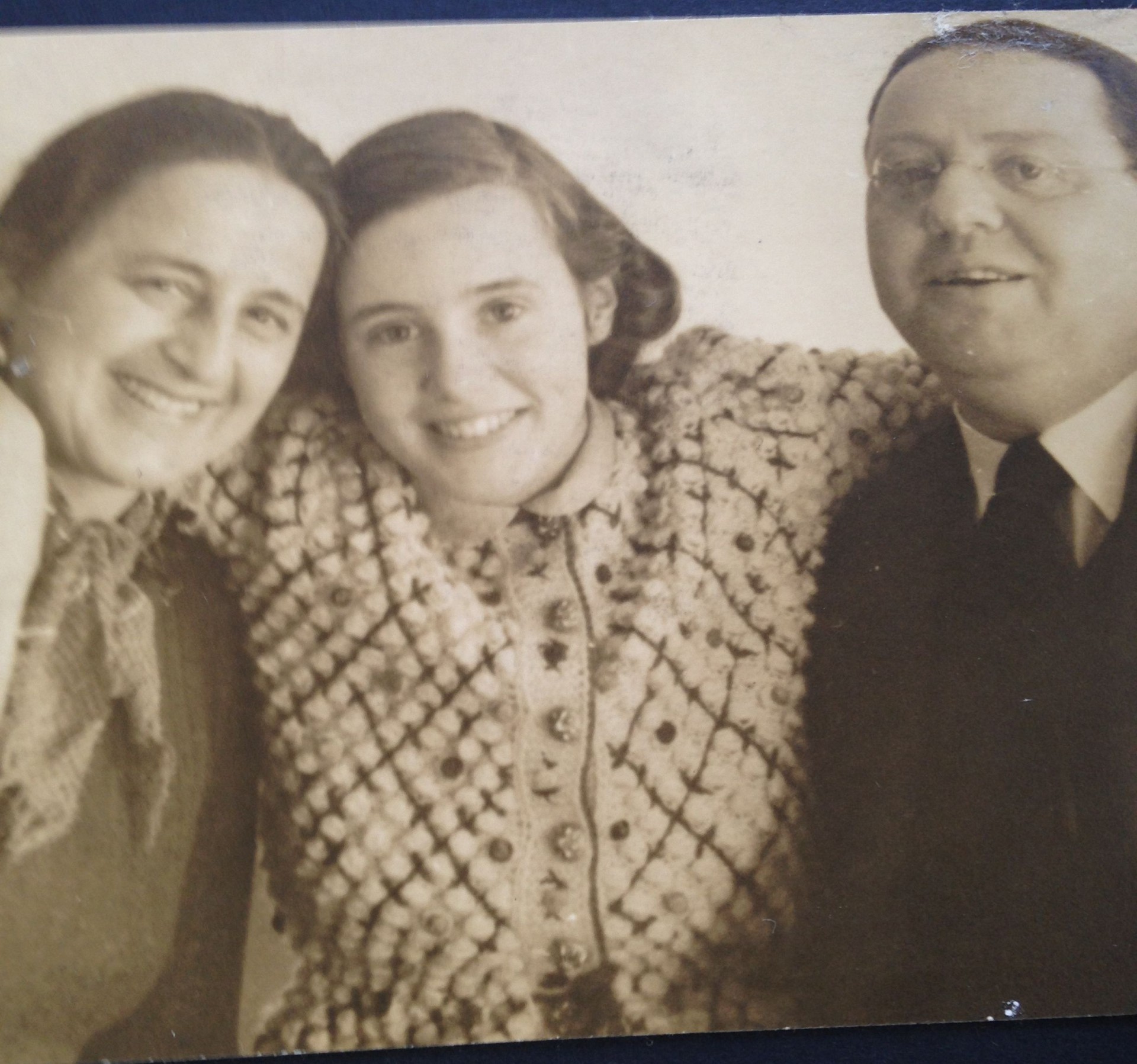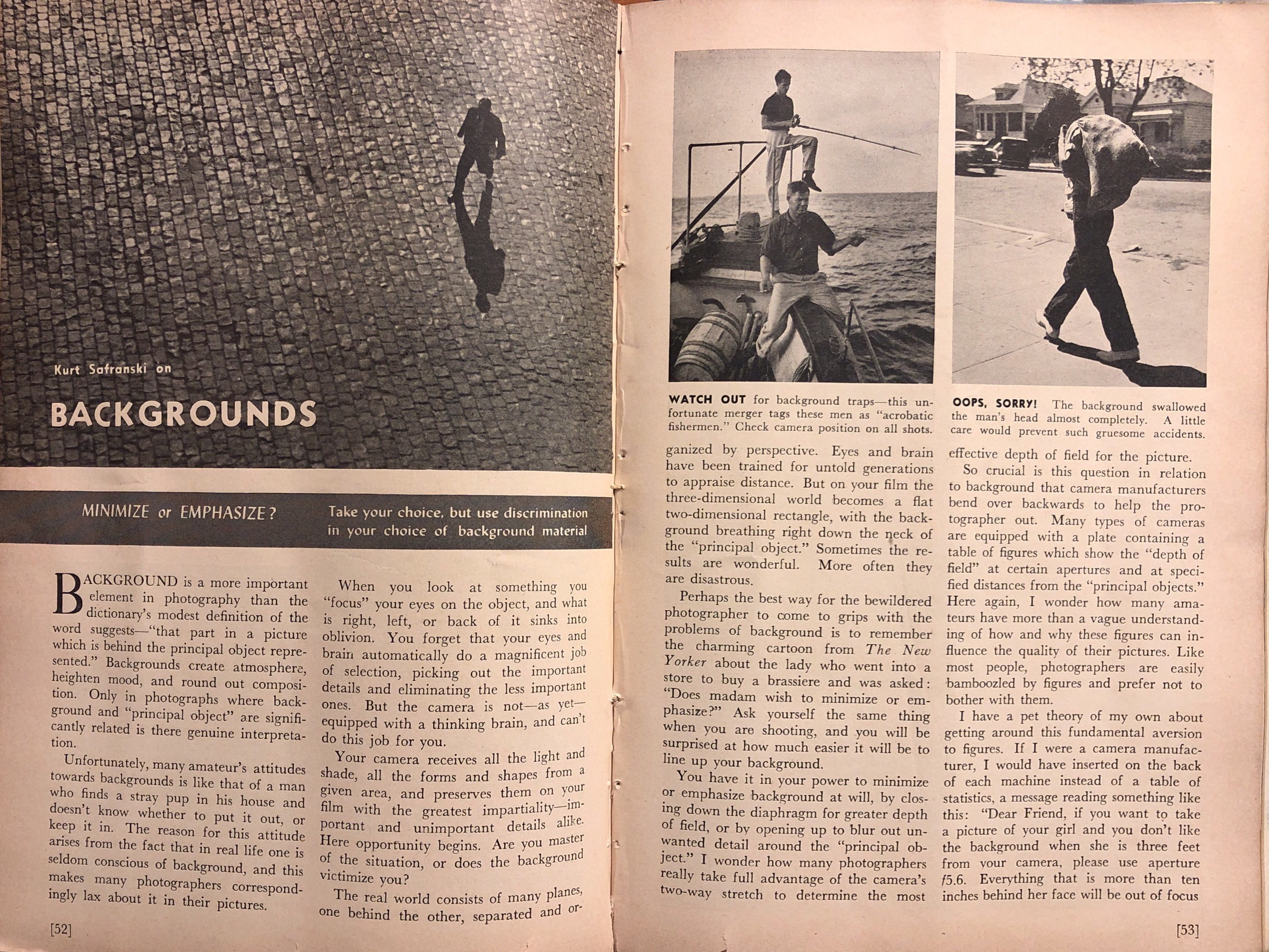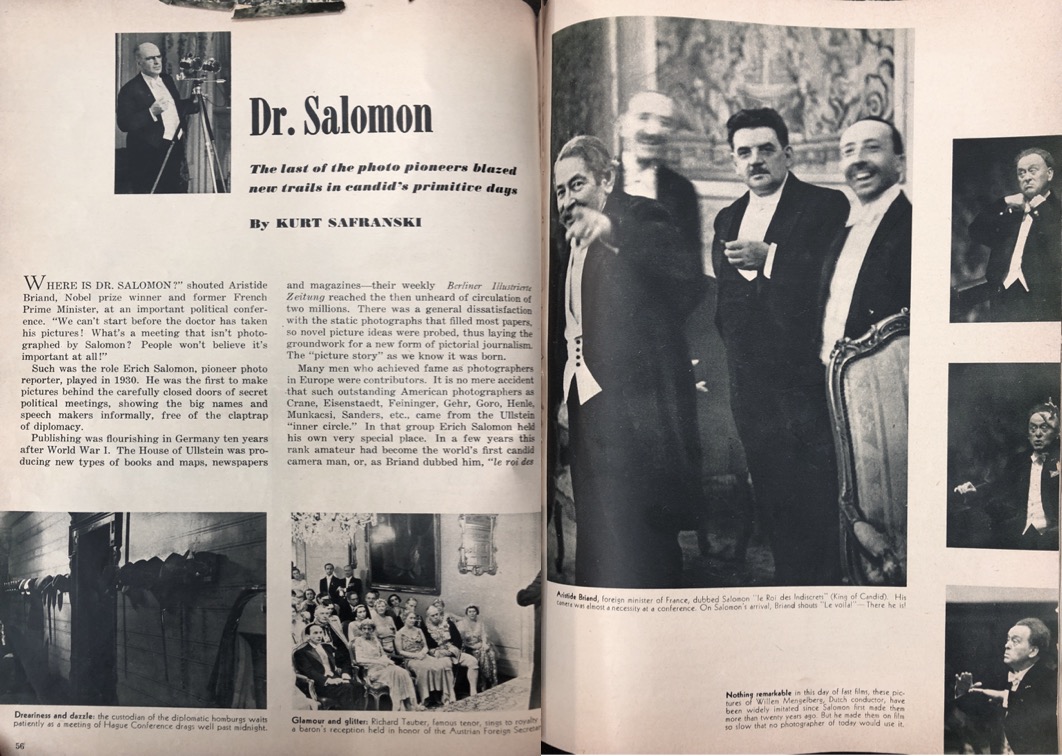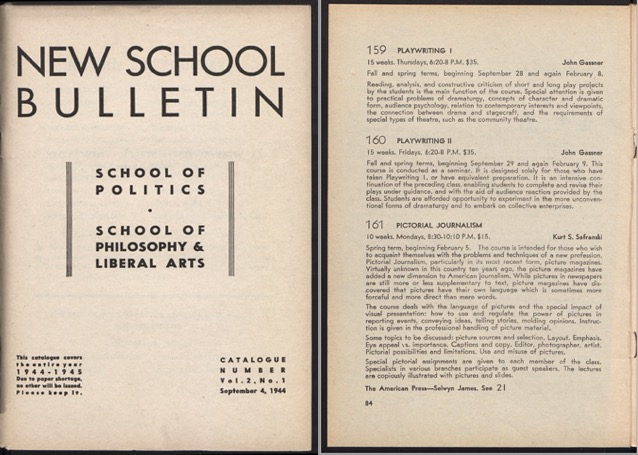Archive
Kurt Safranski
- Kurt
- Safranski
Kurt Szafranski, Kurt Stephen Safranski
- 17-10-1890
- Berlin (DE)
- 01-03-1964
- Kingston (US)
- Picture AgentFounding MemberTeacherCartoonistPublisherIllustrator
Kurt Safranski was one of the founding members of the Black Star photo agency, a teacher at the New School for Social Research and the author of photojournalistic articles and books.
Word Count: 31

Portrait of Kurt Safranski with his wife Maria and daughter Tina Safranski, photographer unknown, n.d. (© Heirs of Kurt Safranski). 
Cover of Selling Your Pictures by Kurt Safranski (Ziff Davis Publishing Company, 1940). 
Kurt Safranski “Backgrounds.” Minicam Photography, July 1945, pp. 52–53 (Photo: Helene Roth). 
Kurt Safranski. “Dr. Salomon.” Popular Photography, August 1948, pp. 56–57. 
Announcement of "Pictorial Journalism" course by Kurt Safranski in New School Bulletin, vol. 2, no. 9, 1944, p. 84 (© New School course catalog collection, NS-05-01-01. The New School Archives). 
Werner Wolff, K.S. Safranski’s Class in Pictorial Journalism, 1950 (New School for Research Archive, Photograph Collection © Steven Wolff). 
Announcement of "Pictorial Journalism. Photographs as a Language and their special Problems" course by Kurt Safranski at the New School for Social Research, Spring 1949 (© The New School Archives and Special Collection, The New School, New York). Chapnick, Howard. Truth Needs No Ally. Inside Photojournalism. University Missouri Press, 1994.
Dogramaci, Burcu, and Helene Roth. “Fotografie als Mittler im Exil: Fotojournalismus bei Picture Post in London und Fototheorie und -praxis an der New School for Social Research in New York.” Vermittler*innen zwischen den Kulturen, special issue of Zeitschrift für Museum und Bildung, vol. 86–87, 2019, pp. 13–44.
Dogramaci, Burcu. Lieselotte Friedlaender (1898–1973). Eine Künstlerin der Weimarer Republik. Ein Beitrag zur Pressegraphik der zwanziger Jahre. Wasmuth, 2001.
Fischer, Ernst. Verleger, Buchhändler & Antiquare aus Deutschland und Österreich in der Emigration nach 1933. Ein biographisches Handbuch. Verband Deutscher Antiquare e.V., 2011.
Gervais, Thierry. The Making of Visual News. A History of Photography in the Press. Translated by John Tittenson, Bloomsbury, 2017.
Gilbert, George. The Illustrated Worldwide Who’s Who of Jews in Photography. G. Gilbert, 1996.
Hartmann, Rainer. „Kurt S. Szafranski - Vier Leben.“ Fotogeschichte, 160, 2021.
Hicks, Wilson. Words and Pictures (The Literature of Photography). Arno Press, 1973.
Keil, Lars-Broder. “‘Eines Tages war er plötzlich wieder da’.” 26 August 2019, Axel Springer. Accessed 1 March 2021.
Kornfeld, Phoebe. Passionate Publishers. The Founders of the Black Star Photo Agency. University of Missouri Press, 2021.
Lieselotte Friedlaender 1898–1973. Schicksal einer Berliner Modegraphikerin, exh. cat. Jüdisches Museum Berlin, Berlin, 1998.
Mayer, Mathilde. Die Alte und die Neue Welt (1951). Arbeitskreis Jüdisches Bingen, 2003. [Original text was completed in 1951 by Ernest Mayer’s mother while in exile in New Rochelle, New York.]
Morris, John Godfrey. Get the Picture. A Personal History of Photojournalism. University of Chicago Press, 2002.
Neubauer, Hendrik. Black Star. 60 Years of Photojournalism. Könemann, 1997.
New York Photography 1890–1950. Von Stieglitz bis Man Ray, edited by Ortrud Westheider and Michael Philipp, exh. cat Bucerius Kunst Forum, Hamburg, 2012.
Oels, David, and Ute Schneider, editors. “Der ganze Verlag ist einfach eine Bonbonniere”: Ullstein in der ersten Hälfte des 20. Jahrhunderts. De Gruyter, 2014.
Safranski, Kurt. Selling your pictures. Ziff Davis Publishing, 1940.
Safranski, Kurt. “Backgrounds.” Minicam, July 1945, pp. 52–56, 109, here: pp. 52–53.
Safranski, Kurt. “Dr. Salomon.” Popular Photography, August 1948, pp. 56–59, 104–108.
Schaber, Irme. “Fotografie.” Handbuch der deutschsprachigen Emigration 1933–1945, edited by Claus-Dieter Krohn and Patrick von zur Mühlen, WBG, 1998, pp. 970–983.
Smith, C. Zoe. “Émigré photography in America: contributions of German photojournalism from Black Star Picture Agency to Life magazine, 1933–1938.” (unpublished dissertation, School of Journalism in the Graduate College of the University of Iowa, Iowa City, December 1983).
Smith, C. Zoe. “Black Star Picture Agency: Life’s European Connection.” Journalism History, vol. 13, no. 1, 1986, pp. 19–25.
Smith, C. Zoe. “Die Bildagentur ‘Black Star’. Inspiration für eine neue Magazinfotografie in den USA.” Kommunikation visuell. Das Bild als Forschungsgegenstand – Grundlagen und Perspektiven, edited by Thomas Knieper and Marion G. Müller, Herbert von Halem, 2001, pp. 240–249.
Torosian, Michael. Black Star. The Ryerson University Historical Print Collection of the Black Star Publishing Company. Portfolio Selection and Chronicle of a New York Photo Agency. Lumiere Press, 2013.
Vowinckel, Annette. “German (Jewish) Photojournalists in Exile. A Story of Networks and Success.” German History, vol. 31, no. 4, December 2013, pp. 473–496.
Werneburg, Brigitte. “LIFE: Leben in der Emigration. Deutsche Fotojournalisten in Amerika.” (unpublished manuscript, 1991). werneburg.nikha.org. Accessed 15 February 2021.
Word Count: 491
Black Star Collection, Ryerson Image Centre, The University of Toronto, Toronto.
Clara Meyer Papers, The New School Archives and Special Collections, New York.
Digital Collection, Berlinische Galerie, Berlin.
Leo Baeck Institute, New York.
Word Count: 41
My deepest thanks go to Phoebe Kornfeld, the granddaughter of Kurt Kornfeld, and the heirs of Kurt Safranski for providing me with information and archival material.
Word Count: 26
New York, US (1934–1958).
Park Crescent Hotel, 150 Riverside Drive, Upper West Side, New York City (residence, 1934–1936); 116 Calhoun Avenue, New Rochelle, New York (residence, 1936–1939); 122 East Brookside Drive, Larchmont, New York (residence, 1939–1958); Woodstock, New York (1958–1964); Hearst Magazine Division, 57th West 8 Avenue, Midtown Manhattan, New York City,(workplace, 1934–1936); Black Star Photo Agency, Graybar Building, 420 Lexington Avenue, Midtown Manhattan,New York City (workplace, 1937–1942); Office of War Information, 122 East 42nd Street, Midtown Manhattan, New York City (1942–1944); Black Star Photo Agency, Graybar Building, 420 Lexington Avenue, Midtown Manhattan, New York City (workplace, 1944–1953; 1954–1957); Black Star Photo Agency, 305 East 47th Street, Tudor City, New York City (1957).
- New York
- Helene Roth. "Kurt Safranski." METROMOD Archive, 2021, https://archive.metromod.net/viewer.p/69/2948/object/5138-7719697, last modified: 26-04-2022.
-
Walter SandersPhotographerNew York
Walter Sanders was a German émigré photographer. In 1938 he arrived in New York, where he worked from 1939 until the end of his life for the Black Star agency and, from 1944, for Life magazine.
Word Count: 33
Werner WolffPhotographerNew YorkWerner Wolff was forced to leave Germany in 1936 due to his Jewish background and emigrated via Hamburg to New York, where he could follow his career as photographer and photojournalist.
Word Count: 30
Andreas FeiningerPhotographerWriterEditorNew YorkAndreas Feininger, was a German émigré photographer who arrived in New York with his wife Wysse Feininger in 1939. He started a lifelong career exploring the city's streets, working as a photojournalist and writing a large number of photography manuals.
Word Count: 39
Ruth BernhardPhotographerNew YorkRuth Bernhard was a German émigré photographer who lived in New York from the 1920s to the 1940s. Beside her series on female nudes, her place in the photography network, as well as in the New York queer scene, is unknown and understudied.
Word Count: 43
Lisette ModelPhotographerNew YorkLisette Model was an Austrian-born photographer who lived in New York with her husband Evsa Model after emigrating from France. Her street photographs capturing the curiosities of everyday life quickly caught the interest of museums and magazines.
Word Count: 37
Fred SteinPhotographerLawyerNew YorkAlways accompanied by his camera, the German émigré photographer Fred Stein discovered New York City during the 1940s and 1950s. His pictures provide an human and multifaceted view of the metropolis.
Word Count: 31
Alexey BrodovitchPhotographerArt DirectorGraphic DesignerNew YorkAlexey Brodovitch was a Belarus-born émigré graphic artist, art director and photographer who, from 1933, worked in New York for Harper’s Bazaar magazine and at the New School for Social Research.
Word Count: 31
Charles LeirensPhotographerMusicianMusicologistNew YorkCharles Leirens was a Belgian-born musician and photographer who emigrated to New York in 1941. While publishing two books on Belgian music, he also gave courses in musicology and photography at the New School for Social Research.
Word Count: 36
Marion PalfiPhotographerNew YorkMarion Palfi was a German émigré photographer who lived in New York from the 1940s to the 1960s. Her photographic engagement in social and political topics made her name for her use of the camera to draw attention to social injustices.
Word Count: 41
Lotte JacobiPhotographerNew YorkIn October 1935 the German émigré photographer Lotte Jacobi, together with her sister Ruth Jacobi, opened a photo studio on 57th Street. The two sisters had to leave their parents' photo studio in Berlin in the 1930s and emigrated to New York.
Word Count: 41
Tim GidalPhotographerPublisherArt HistorianNew YorkTim Gidal was a German-Jewish photographer, publisher and art historian emigrating in 1948 emigrated to New York. Besides his teaching career, he worked as a photojournalist and, along with his wife Sonia Gidal, published youth books.
Word Count: 35
Ruth JacobiPhotographerNew YorkRuth Jacobi was a German-speaking, Polish-born photographer who emigrated in 1935 to New York, where she opened a studio together with her sister Lotte Jacobi. She later had her own portrait studio.
Word Count: 31
Fritz HenlePhotographerNew YorkFritz Henle was a German Jewish photographer who emigrated in 1936 to New York, where he worked as a photojournalist for various magazines. He also published several photobooks of his travels throughout North America and Asia.
Word Count: 35
Kurt KornfeldPublisherPicture AgentFounding MemberNew YorkKurt Kornfeld was a publisher and literary agent and a founding member of the Black Star photo agency in New York City after his emigration in 1936 to New York.
Word Count: 29
Ernest MayerPicture AgentFounding MemberPublisherNew YorkErnest Mayer was co-founder of the Black Star Publishing Company photo agency, which built a network for émigré photographers and the American magazine scene from the mid-1930s until the end of the 1950s.
Word Count: 34
Carola GregorPhotographerSculptorNew YorkThe German émigré photographer Carola Gregor was an animal and child photographer and published some of her work in magazines and books. Today her work and life are almost forgotten.
Word Count: 30
Trude FleischmannPhotographerNew YorkTrude Fleischmann was an Austrian-Jewish portrait and dance photographer who emigrated in 1939 to New York, where she opened a studio in Midtown Manhattan with the photographer Frank Elmer.
Word Count: 28
Black Star AgencyPhoto AgencyNew YorkThe German émigrés Kurt S(z)afranski, Ern(e)st Mayer and Kurt Kornfeld founded Black Star in 1936. The photo agency established was a well-run networking institution in New York.
Word Count: 31
New School for Social ResearchAcademy/Art SchoolPhoto SchoolUniversity / Higher Education Institute / Research InstituteNew YorkDuring the 1940s and 1950s emigrated graphic designers and photographers, along with artists and intellectuals, were given the opportunity to held lectures and workshops at the New School for Social Research.
Word Count: 31
SpiratonePhoto SupplierNew YorkSpiratone was a photo company and photo supplier founded in 1941 by the Austrian émigré family Hans (1888–1944) and Paula Spira (?–?) and their son Fred Spira (1924–2007).
Word Count: 24
Josef BreitenbachPhotographerNew YorkOn arriving in New York in 1941, the German photographer Josef Breitenbach tried to restart as a portrait, street and experimental photographer, as well as a teacher of photo-history and techniques.
Word Count: 30
Erika StonePhotographerNew YorkErika Stone is a German émigré, who moved to New York with her parents and sister in December 1936, at the age of 12. She went on to carve out a career as photographer.
Word Count: 32
Lilly JossPhotographerNew YorkLilly Joss was an émigré freelance photographer in New York. She worked for the Black Star photo agency and magazines and was also a portrait and theatre photographer.
Word Count: 28
Black Star Publishing Company LondonPhoto AgencyLondonThe 1936 New York-founded Black Star Publishing Company photo agency opened a European branch in London the same year in response to the high demand for foreign images in the U.S.
Word Count: 31